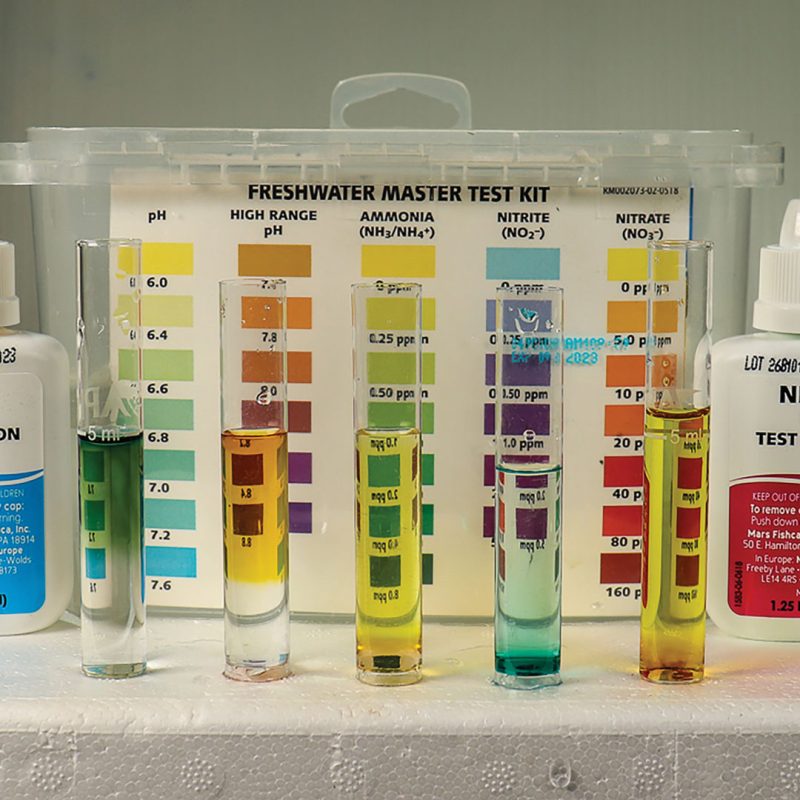Pond Maintenance
Guide to Pond Water Alkalinity
As pond owners are well aware, water quality is vital to the health and well-being of your Koi and Goldfish. Monitoring water quality parameters is an essential part of Koi keeping. However, one pond parameter often overlooked is alkalinity, or KH. KH impacts ammonia, nitrite, nitrate, and pH levels. Low KH levels can cause serious issues in your pond and negatively impact your fish’s health. If you don’t know much about pond alkalinity, you’re in the right place! Learning the basics of pond alkalinity will help you ensure this important water quality parameter is properly balanced in your pond.
What Is Alkalinity?
Alkalinity, or carbonate hardness, is the measure of carbonate and bicarbonate concentrations in pond water. In other words, it’s the measure of the buffering capacity of water–or its ability to neutralize acid without changing pH. Although occasionally defined as different entities, alkalinity and KH are typically used interchangeably in the pond world and considered the same parameter in almost all pond testing kits. Alkalinity is expressed as milligrams per liter (mg/L) or parts per million (ppm) of calcium carbonate (CaCO3).
Why Is Alkalinity Important?
The pH of pond water naturally fluctuates throughout the day. These changes are primarily a result of changes in carbon dioxide levels caused by photosynthesis. Plants carry out photosynthesis while the sun is shining, absorbing carbon dioxide from the water, which reduces carbonic acid (H2CO3) and causes pH levels to rise. At night, plants consume oxygen from the water and release carbon dioxide through respiration. This leads to increased carbonic acid and a drop in pH levels. If the KH levels in your pond are adequate, there are enough carbonates to buffer these changes and keep your pH stable.
KH prevents these fluctuations of pH levels in your pond from occurring too quickly or drastically. Without enough alkalinity, your pond could experience significant swings in pH. This is important because sudden changes in pH can be harmful to the overall health of your fish. High KH indicates a better buffering capacity, meaning changing the pH level is more difficult. Low KH means less buffering capacity and pH levels can fluctuate more easily.
Aside from its role in pH stabilization, alkalinity also aids in the biological operations of certain pond organisms. Plants, bacteria, and fish all need a certain level of mineral carbonate to carry out essential biological functions. During the de-nitrification process, beneficial bacteria in your pond and filter consume a large number of carbonates while breaking down waste. Koi also require some calcium carbonate for healthy bodily functions, specifically to help regulate salts within the blood.
Signs of Low KH
As mentioned previously, low KH in your pond means less buffering capacity, which can lead to drastic swings in pH. The biggest indicator of low KH levels in your pond is a crash in pH levels. This could be especially noticeable after a rainstorm. Rain can be fairly acidic, depending on your region. KH can neutralize this acid. If your pond has low KH levels, this neutralization cannot occur, and pH levels will drastically drop after a rainstorm. Low pH is an invisible issue, so routine water testing is important. Left unchecked, low pH can harm your pond and your fish. Some indicators of a pH crash include lethargic fish activity, fish gasping for air, damaged aquatic plants, and overgrowth of algae.
How to Test Alkalinity
Testing the alkalinity in your pond is fairly simple. All you need is a water test kit that measures KH or carbonate hardness. Most of the tests on the market are combination tests for general hardness and carbonate hardness. Total alkalinity levels are typically expressed as milligrams per liter (mg/L) or parts per million of calcium carbonate (caCO3). In Koi ponds, the ideal range for alkalinity (KH) is 75 to 200 mg/L (ppm) CaCO3.
How to Increase KH
If your KH drops below the recommended range, you’ll need to add carbonates to the water. The simplest way to do this is with baking soda. Fill a bucket with pond water and add ¼-½ cups of baking soda per 1000 gallons of water in your pond. Let the baking soda dissolve, then add the baking soda and pond water mix back into your pond. Repeat this process every 24 hours until your KH levels return to a suitable range. Because baking soda has a pH of 8.5, it will not raise the pH of your pond water higher than 8.5, which is still in a suitable range for Koi.
Looking for a few new additions to your backyard pond? Shop our full selection of Koi and Goldfish today.




